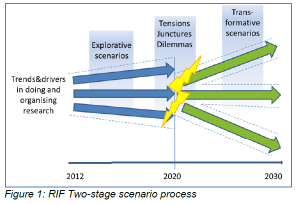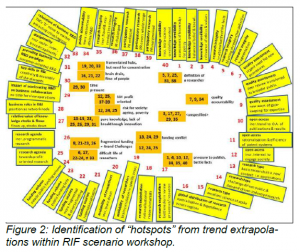RIF explores possible future ways of doing and organising research in order to inspire fresh thinking among research stakeholders about underlying potentials and looming risks in the present.
Drivers for New Ways of Doing Research
RIF was setting out from the observation that current ways of doing and organising research are experiencing a number of new phenomena, challenges and tensions such as:
- Increasing demand for public participation in defining research priorities
- Demand for early economic exploitation of research findings and subsequent protection of intellectual property right
- Increasing call for creation of socially robust knowledge
- Emergence of diversity of knowledge claims challenging the monopoly of “science” such as the Rise of citizens scientists
- New technologies changing science practises such as big data, computer simulation, researcher social networks and e-publishing
- Call for open access to research findings
- Established publishing modes challenged by new players
- Institutional diversification and change of established division of roles
- Increasing engagement of industry in research activities
- Turn in Research and Innovation Policy towards mission oriented strategies
- Established notions of science excellence being contested
- Increasing relevance of large technical infrastructures
- Change in the global landscape of research, emergence of new countries leading publications
Tackling Tensions of Future Research Governance
In view of this background the RIF Foresight exercise defined the following objectives:
- Systematize knowledge of the emerging patterns, trends and drivers of change of ways of doing and organising research.
- Develop medium-term explorative scenarios of possible future models of doing and organising research in our knowledge societies at a time horizon 2020
- Anticipate and assess possible challenges and tensions resulting from these scenarios
- Develop long-term transformative scenarios of alternative development paths of the way we will do and organize research and innovation in our societies at a time horizon of about 2030
- Identify policy issues and strategic options for the actors and stakeholders affected, as resulting from the two types of scenarios
- Create an open debate between different communities contributing to knowledge dynamics from their respective perspectives and explore room for joint action.
Explorative and Transformative Scenarios
The core element of the RIF methodology is a two stage scenario process as shown in figure 1.

In a first stage the RIF team identified current trends and drivers of research practices and organisation through an in-depth stocktaking of literature, forward looking studies and strategy documents (Schaper-Rinkel et al. 2012). In a next step RIF set up a scenario process involving around 70 stakeholders with a wide range of backgrounds and perspectives within three interactive scenario workshops:
In the first workshop participants developed “explorative scenarios” with a mid-term time horizon by extrapolating today’s trends and drivers (c.f. RIF 2012). Out of these explorative scenarios they identified a set of tensions, junctures and dilemmas that could be emerging in the mid-term if current dynamics continue (c.f. figure 2).
The explorative scenario workshop comprised the following interactive methods:
- plenary discussion and multi-criteria assessment for the selection of core trends
- facilitated group brainstorming for projection of the selected factors into the mid-term future
- open-space session for the final identification of tensions (c.f. figure 2)
- self-organised group work for elaboration of the tensions

In the second transformative scenario workshop the RIF team and a few selected external participants with a background in the most relevant issues brought forward by the preceding workshop developed the “nuclei of change” from the previous workshop into draft transformative scenarios within plenary and group brainstorming sessions.
The third scenario workshop was dedicated to validation and enrichment of the transformative scenario drafts. A world café format enabled a constructive and structured futures’ dialogue:
On each world café table the team had placed a characteristic image and short descriptive paragraph for one transformative scenario draft. In group sessions of ca. half an hour participants commented on the drafts and enriched the scenarios. Several rounds were carried out so each participant was able to comment on at least two scenarios. One table had been reserved in case participants proposed additional scenarios, which was indeed the case when an entirely new wild card scenario was proposed by one of the participants.
In the second session participants relating to the four stakeholder groups science, policy, civil society and industry worked in separate groups. In a first step they defined their core strategic objectives with respect to research. Secondly, they assessed opportunities and threats for these targets for all six scenarios.
The RIF project has now arrived at the midterm of its duration. The next two workpackages will be dedicated to stakeholder debate on policy implications and strategic options emerging from the scenarios. For this purpose several participatory foresight workshops will be held. Some of these strategic conversations will be crosscutting while others will address specific stakeholder groups that are facing particularly relevant strategic issues according to the scenario analysis.
Broad Stakeholder Participation
The RIF team selected the participants of the Foresight exercise on the basis of a stakeholder analysis using (among others) the stakeholder classification scheme developed by Mitchell et al (1997). Representatives from the following institutional backgrounds participated in the workshops:
- University based researchers (Professors, PhDs, students)
- University administration
- Research funding agencies
- Foundations active in research funding
- Regional policy agencies
- Public research organisations
- Research Ministries (national and EU level)
- Large companies
- SMEs
- Science shops
- Citzens’ science activists
- Scientific journal editors
- Science quality control agencies
- Industrial associations
- Trade unions
- Health organisations
- International researcher networks
- Large research infrastructures
The majority of the participants came from different European countries representing some organisations from regional, national and European level but also from other continents and international organisations. RIF achieved a good balance between female and male participants.
From Slow Science to Competition 2.0
The RIF project is still on-going. Currently, the scenario report containing the explorative and transformative scenarios emerging from the stakeholder process is being finalised. The insights generated by the stocktaking and draft scenario building are available and summarised below.
The stocktaking (Schaper-Rinkel et al. 2012) pointed out six core dimensions of change in ways of doing and organising research:
- Digitalization and virtualisation
- Cooperation & Participation
- Access
- Impact
- Globalisation & Internationalisation
Within these dimensions the analysis revealed the following tensions:
- open science versus commodification of research
- short-term project-orientation versus long-term development of new forms of research
- abundance of scientific information versus shortage of individually manageable and reliable information
- research collaboration versus competition for research funding
- collaborative research versus individual incentives
- diversity in research versus quality standards
- scientific excellence that is associated with value-free, curiosity-driven research versus research that is relevant to contributing to societal needs
- diversity versus uniformity
- research efficiency versus foundational breakthroughs
- diverse epistemic cultures in providing knowledge for decision-making
The foresight process outlined above generated seven transformative scenario drafts within the first two workshops:
Scenario I: Open Research Landscape
European research is coordinated by “Open Research Platforms (ORP)” where different types of globally connected actors align their funding activities. Each ORP runs an open knowledge sharing WIKI platform where researchers integrate their findings. The new gate-keepers of scientific quality are science & society social networks. University performance is judged by their contribution to the ORPs success.
Scenario II Divided Science Kingdom
The research landscape is divided between two extremes: strictly governed publicly-funded research applying traditional quality criteria versus an open “knowledge parliament” where knowledge claims and funding opportunities are continuously negotiated. Universities are highly diversified according to the two realms
Scenario III: Grand Challenges for real
European research and innovation is strictly organized around Knowledge and Innovation Communities (KICs) that develop solutions for key societal challenges through large scale socio-technical research and experimentation aligning diverse actors and knowledge types. Large shares of public budgets are used to finance the KICs in a coordinated manner. This happens in a period of reduced economic growth in Europe, where higher priority is given to other dimensions of quality of life.
Scenario IV: Tailored Research
The research landscape is coordinated through a fully tailored system of functions fulfilled by highly specialised actors that share revenues according to market rules. At the top of the pyramid, Research Assembling Organisations (RAOs) integrate the contributions of second and third tier research service providers into systemic solutions. A few actors define the rules of interaction and control access to research results and resources. Science is viewed as one of the key enablers for winning the global competition race.
Scenario V: Slow Science
A dedicated group of scientists, also known as “slow science community”, is orienting re-search towards societal and policy needs and placing high emphasis on work-life balance and on making the results of their research work effective in practice. The community is locally rooted, globally connected and funded by bottom-up crowd-funding from diverse sources.
Scenario VI: Competition 2.0 – European public research divided
Driven by business pressure, the Europe’s emphasis is on innovation-oriented research with a focus on improving mid-term global competitiveness. Independent basic research has almost vanished and struggles for funding from public sources.
Scenario X Happiness 2030
To reach the ambitious requirements of wellbeing and happiness until 2030, by 2020 a fully distributed research system based on virtual open science communities, micro-funding and real science markets emerges. Virtual communities grow stronger due to shared methods and processes, affordable tools and applications, as well as to ambitious young talents working and striving for societal reputation. Social science entrepreneurs are climbing up the ladder of success and foster bottom‑up innovation.
These scenario drafts are now being consolidated on the basis of the input from the third workshop which is documented in RIF 2012. The full scenario report will be available soon after.
Changing Value System in Research & Innovation
It is too early yet to draw definite conclusions and policy implications from the RIF foresight exercise. Already now it becomes clear however that longstanding certainties are becoming volatile and the future of research will pose major challenges to decision makers on all levels and institutional backgrounds. The lively debates around the “policy table” in the Vienna world cafe on pros and cons of the various scenarios revealed several valuable strategic questions for policy making today. Accordingly we expect the emergence of a number of relevant policy implications from the strategic debate within the two next work packages:
- Scenario implication assessment (WP3)
- Strategic options for society and policy (WP4).
The scenario report will present a consolidated version of the scenarios based on the inputs from the third workshop.
| Authors: | Philine Warnke philine.warnke@ait.ac.at | ||||
| Sponsors: | European Commission DG RTD Science in Society | ||||
| Type: | European level thematic exercise | ||||
| Organizer: | Matthias Weber, AIT Austrian Institute of Technology GmbH, and matthias.weber@ait.ac.at | ||||
| Duration: | 2011-2013 | ||||
| Budget: | € 860 ,000 | ||||
| Time Horizon: | 2020/2030 | ||||
| Date of Brief: | January 2013 | ||||
Download EFP Brief 255_RIF Research and Innovation Futures
Sources and References
More information on the RIF project including all reports for download can be found at: http://www.rif2030.eu/
Amanatidou, E., Cox, D., Saritas, O. (2012): RIF Deliverable 4.1: Stakeholders in the STI System.
Mitchell, R. K., Agle, B. R. and Wood, D. J. (1997), ‘Toward a Theory of Stakeholder Identification and Salience: Defining the Principle of Who and What Really Counts’, The Academy of Management Review, 22 (4), 853–886.
Schaper-Rinkel, P., Weber, M., Wasserbacher, D., van Oost, E., Ordonez-Matamores, G., Krooi, M., Hölsgens, R. Nieminen, M., Peltonen, A. 2012: RIF Deliverable 1.1 Stocktaking Report.
RIF 2012: Research in Europe 2030: Documentation of the RIF Vienna World Café. http://www.rif2030.eu/wp-content/uploads/2012/12/RIF-Docu-World-cafe-Vienna_final.pdf
(Links for further information, references used, etc.)